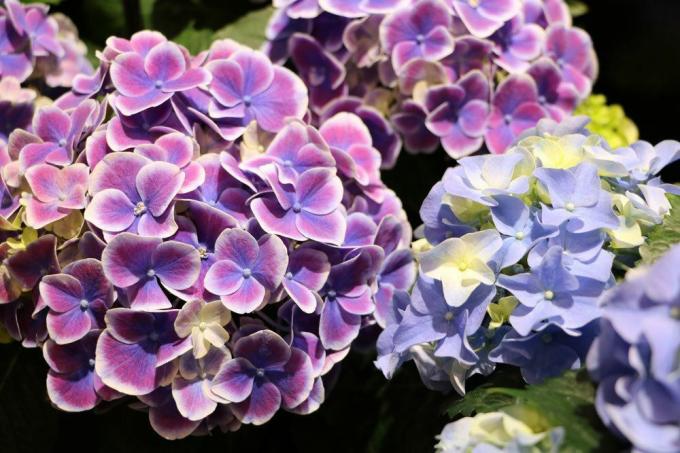
table of contents
- Hydrangea varieties
- Farmer's hydrangeas (Hydrangea macrophylla)
- Panicle hydrangeas (Hydrangea paniculata)
- Snowball hydrangeas (Hydrangea arborescens)
- Oak leaf hydrangea (Hydrangea quercifolia)
- Velvet hydrangea (Hydrangea sargentiana)
- Climbing hydrangeas (Hydrangea petiolaris)
- Japanese tea hydrangea (Hydrangea serrata)
The hydrangea is one of the most popular plants in German gardens. All hydrangea species originally come from America and Asia. They impress with enchanting flowers that, depending on the hydrangea variety, fill gardens with color from spring to autumn. There are many different types and varieties of hydrangea available to suit all needs and tastes. The plant magazine Plantopedia has put together an overview of the most relevant specimens.
Hydrangea varieties
Farmer's hydrangeas (Hydrangea macrophylla)
The farmer's hydrangea originally comes from Japan. For many years it has made a name for itself in Central Europe and is considered the queen of all hydrangea species. This is due not least to the countless variations of striking flowers. which she presents in a spherical or plate-like shape. It has sterile pseudo-flowers. That is, they are not used to reproduce seeds, as is the case with other hydrangea species.
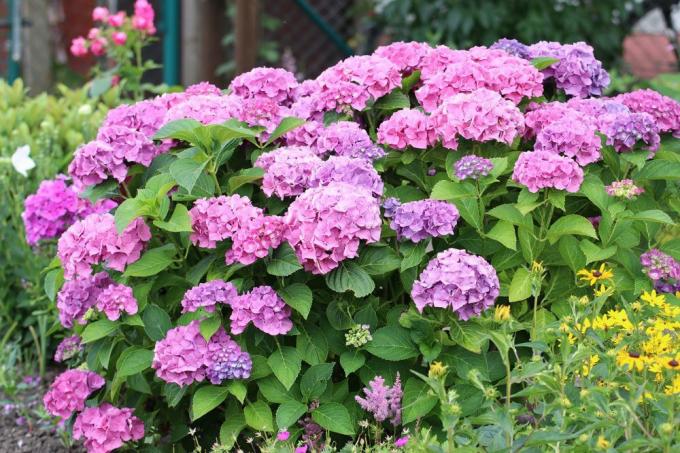
Special features / properties
the Hydrangea macrophylla offers several different hydrangea varieties that reach a height of between 100 centimeters and 150 centimeters and a width of 100 centimeters to about 130 centimeters. Particularly hard-working specimens can also grow to over 200 centimeters with an identical width.
The colors are varied and range from white to pink tones to red. One phenomenon is the possible color change of pink and red colored hydrangeas. This can be done via an aluminum fertilizer or when planting in acidic soil Hydrangea flowers turn into blue and purple. The flowering period begins, depending on the variety, usually in June / July and ends in September.
Farmer's hydrangea varieties:
(Ball-shaped flowers)
Endless summer
- flowers from May to October
- many flowers on new shoots and old wood
- Flower color: pink or blue
- blooms several times a season
- Growth height: up to 150 centimeters
- suitable for keeping in pots
Forever & Ever
- many, small inflorescences
- Flower colors: white, pink, red, blue
- Flowering period: June to September
- Height: 70 to 90 centimeters
- bushy growth
- suitable as a cut flower
Kanmara
- particularly large flower "balls"
- Strong dark green foliage
- Flower color: pink, pink, champagne, purple, white
- Flowering period: June to September
- Height: between 100 and 150 centimeters
- compact growth - ideal for cultivation in pots
Magical
- Flowering period: June to October
- Flower color: white, pink, red, blue, purple
- multiple flower color changes
- Growth height: up to 120 centimeters
- plate-shaped flowers
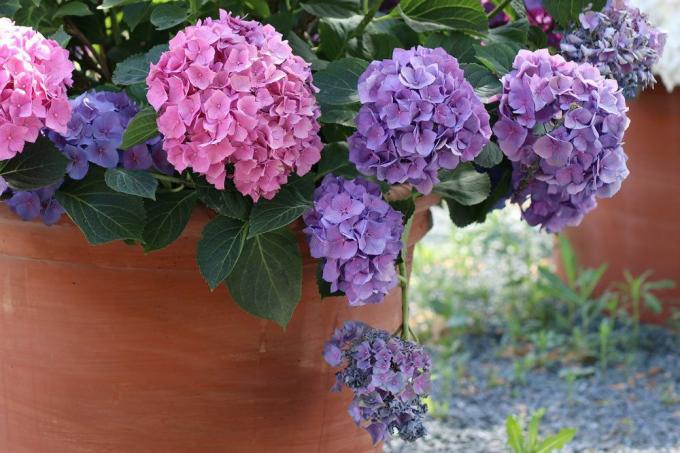
Hanabi
- double flowers
- slow, bushy growth
- sensitive to frost
- Flower color: white
- Flowering period: July to September
- Height: a maximum of 150 centimeters
- already forms the buds for the following year in autumn
Pirates gold
- green-yellow variegated foliage
- marginal flowers
- Flower color: pink
- Flowering period: June to September
- Growth height: up to 120 centimeters
Tiffany
- cupped flowers
- Flowering period: June to September
- Flower color: pink, blue, lavender (bloomed)
- Height: up to 150 centimeters
You and Me Romance
- flat-headed inflorescence
- above average flower size
- double flowers
- Flower color: pink, light blue
- Flowering period: May / June to September
- Height: 70 to 100 centimeters
Panicle hydrangeas (Hydrangea paniculata)
As the name suggests, panicle hydrangea varieties have a panicle-shaped inflorescence. They only form their flowers on fresh wood. By regular cutting these hydrangeas can get a compact and highly branched growth. Specimens that have a long flowering period change their color to soft pink towards the flowering stage.
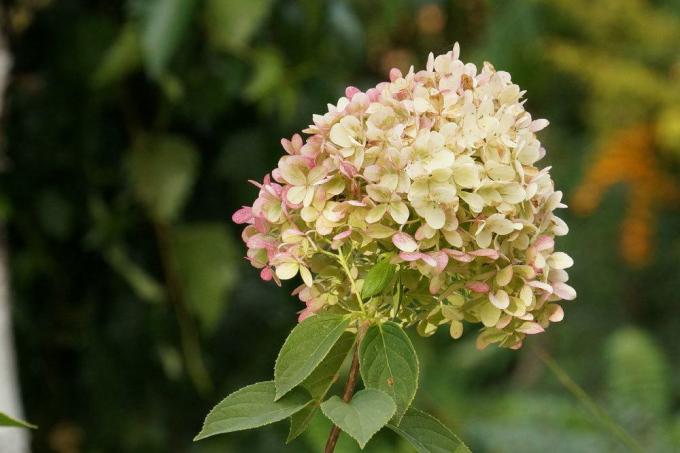
Special features / properties
The panicle hydrangeas usually reach an immense growth height, which, depending on the variety, can be up to 300 centimeters. Some panicle hydrangea varieties take up a lot of space because they are very spreading and spread out. They are among the fast-growing varieties and fill gardens with a pleasant scent of flowers.
Panicle hydrangea varieties:
Grandiflora
- long panicles up to 30 centimeters
- medium-high growth of up to 200 centimeters
- Flowering period: June to September
- Flower color: white, cream-white
Limelight
- panicles up to 30 centimeters in size
- Flower color: white to light yellow
- Flowering period: July to October
- Height: between 150 and 200 centimeters
Little Lime
- particularly floriferous
- compact growth
- fragrant flowers
- Flower color: cream-white, lime green, pink color of ripe flowers
- Flowering period: July to September
- Growth height: up to 120 centimeters
phantom
- compact, upright growth
- needs to be cut regularly
- Flowering period: August to October
- Flower color: white, cream-white, pale pink
- Growth height: up to 250 centimeters

Wims Red
- airy, loose flowers
- Broad growth up to 200 centimeters
- Height: between 150 and 300 centimeters
- Flowering period: July to September
- Flower colors: cream-white, white - changes to pink and dark red towards the blooming
- smells of honey
Snowball hydrangeas (Hydrangea arborescens)
Among the hydrangea species, the snowball hydrangea is one of the most popular and widespread examples in German gardens.
Special features
It impresses with its extraordinary robustness and is absolutely insensitive to frost. Its snowball-shaped, large flowers are relatively heavy, so that especially thin branches often hang down due to the weight. Because of this, regular pruning is required. They belong to the medium-sized hydrangea species, although some plants remain relatively small. Others, however, are just as wide as they are tall.
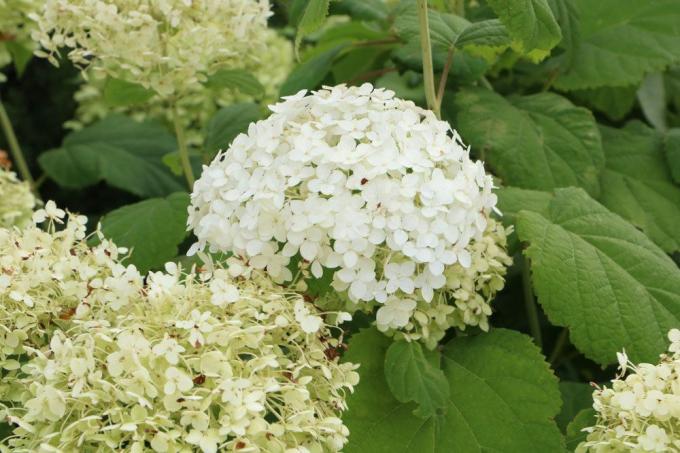
Snowball hydrangea varieties:
Annabell
- Flower color: cream-white, white that becomes increasingly green shortly before wilting
- Flowering period: June to August
- Growth height: up to 200 centimeters
- Spread: up to 200 centimeters
Hayes starbust
- newer breed
- double flowers
- very dense growth
- Flower color: cream-white with greenish accents
- Flowering period: June to September
- Height: between 50 and 120 centimeters
Oak leaf hydrangea (Hydrangea quercifolia)
The oak leaf hydrangea is native to the southeastern United States. It takes its name from the North American Oak Thanks to the fact that its leaves change color in autumn like oaks and have an oak-leaved shape. Accordingly, they are very similar to the North American oak.

Special features / properties
The oak leaf hydrangea varieties emit a scent that can be perceived even from a few meters away. They are very floriferous. With their bushy growth and a height of up to 170 centimeters, they offer plenty of space for countless panicles. Cinnamon-colored annual shoots create a special contrast.
As a rule, all hydrangea varieties grow upright. With age, runners can form all around. Some varieties have the shortest flowering time of any hydrangea species. But it also impresses with its autumn leaves, which are presented in earth-colored red tones and bring color to the garden on gray days even without flowers. Small specimens usually have upright panicles. In larger versions, they usually hang down.
Oak leaf hydrangea varieties:
Harmony
- 30 centimeters long drooping panicles
- Flowering period: July to September
- Flower color: cream colored
- Growth height: up to 300 centimeters
- more fragrant
Pee wee
- short stature
- Flowers grow in a pyramid shape
- Height: a maximum of 150 centimeters
- 15 cm long, upright flower umbels
- Flowering period: June to August
- Flower color: white - become pink and red-purple in the course
- slightly fragrant
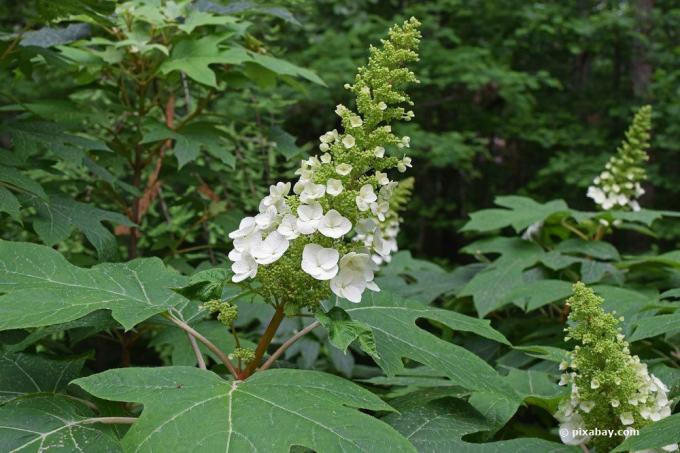
Snow flake
- pyramidal and double-filled flower umbels
- 30 centimeters long drooping panicles
- purple foliage in autumn
- Flower color: snow white with a color change to pink during the withering phase
- Flowering period: late blooming in mid / late July to September
- Growth height: up to over 200 centimeters
Snow Queen
- Upright flowers 20 centimeters
- Flower color: white with a later transition to pink
- Flowering period: July to August
- Height: around 150 centimeters, rarely up to 200 centimeters (also in width)
- slightly fragrant
Velvet hydrangea (Hydrangea sargentiana)
This garden plant presents itself with velvety leaves. It is one of the vigorous hydrangea species. It can grow as a shrub or as a small tree. They are ideally suited for cultivation in pots. It is less hardy than the other hydrangeas. This should be taken into account when choosing a location. This hydrangea is also known under the name "Fellhortensie", which is due to the hair on the leaves.
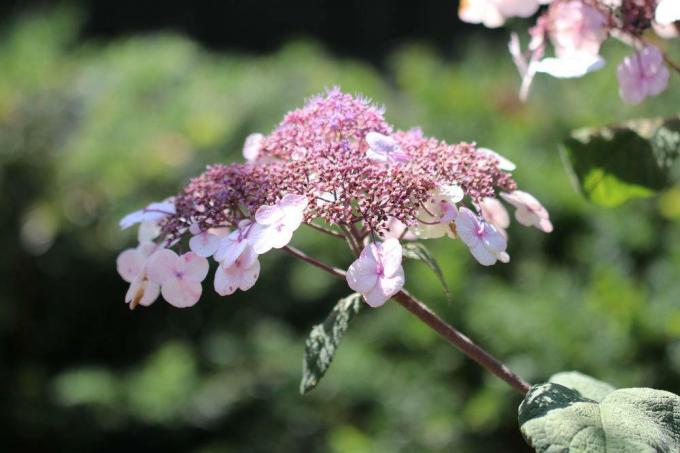
Special features / properties
This type of hydrangea is one of the few that shows itself with a two-tone flower from the start. These are sterile so that their seeds cannot be used for reproduction. It belongs to the medium-sized hydrangea species, although some varieties can reach a height of well over three meters under optimal site conditions. They are conditionally hardy. They often react sensitively to extreme cold and require special protection against the cold.
Velvet hydrangea varieties:
Hydrangea aspera ssp. sargentiana
- Leaves covered with slightly bristle hairs on the underside
- Flowering period: July to August
- Flower color: outer flowers pink-white to white, inner flowers light purple
- Height: between 200 and 350 centimeters (just as wide)
Macrophylla
- The flower umbels are 25 centimeters in diameter
- Flower colors: outer flowers white, pink, inner flowers red, pink - in acidic soil blue, blue-violet
- Flowering period: July to August
- Height: between 150 and 200 centimeters
Mauvette
- plate-shaped inflorescences
- Flowering period: July to August
- Flower color: white outer flowers, mauve inner flowers
- dark green leaf dress
- Growth height: up to 200 centimeters
- Spread: up to 200 centimeters
Climbing hydrangeas (Hydrangea petiolaris)
Climbing hydrangeas are perfect for boring walls and facades. Among the hydrangea species, they are the first to bloom in the gardening season. The special thing about them is that they can be used for a hemispherical shrub or as a ground cover in the garden bed.
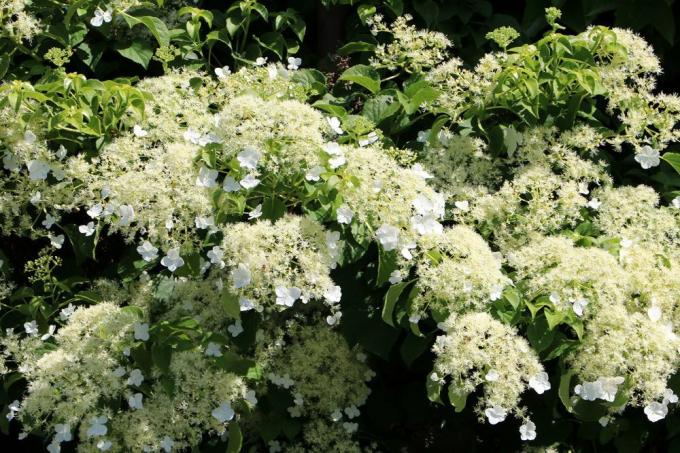
Special features / properties
What is particularly striking about climbing hydrangeas are the glossy leaves that grow in a rounded or egg shape on long petioles. In autumn they take on a yellowish color. Some varieties keep their green foliage over the mild winter months until the next year. They consist of sterile outer flowers and fertile inner flowers. This type of hydrangea already forms its buds in autumn. Protection against the cold in cold winters protects against a lack of flowering in the following year.
Climbing hydrangea varieties:
Cordifolia
- Dwarfism
- deciduous leaf dress
- Flowering period: June to July
- Flower color: cream-white
- Growth height: free-standing approx. 60 centimeters, as a climbing plant up to 300 centimeters
Miranda
- yellow variegated leaves
- large flowers
- Flowering period: June to July
- Flower color: cream-white
- Growth height: up to 300 centimeters
Semiola
- new breed
- evergreen leaf dress
- Flowering period: May to June
- Flower color: white
- Growth height: up to 250 centimeters
Silver lining
- white-green variegated leaves
- Flowering period: July to August
- Flower color: white
- Growth height: as a tendril up to 15 meters, otherwise 150 to 200 centimeters high and wide
- well suited as a container plant
Japanese tea hydrangea (Hydrangea serrata)
The name goes back to the last centuries when sweetness was discovered in the leaves of this hydrangea, which the Asians used for their tea. In fact, it contains the sweetener dulcin, also known under the name "phyllodulcin". This has a sweetening effect 250 times stronger than conventional sugar. In Asia, the tea hydrangea usually grows wild. In Germany, it is planted specifically in gardens and parks because it enchants you with vigorous flower growth early in the year.

Special features / properties
It looks a lot like the plate hydrangea, but its plate-shaped flowers are smaller. The plant is very easy to care for and with a pronounced winter hardiness can withstand cold temperatures below zero. It belongs to the small hydrangea varieties. If it is planted in acidic soil or if it is supplied with aluminum fertilizer, the flower color changes to blue or purple.
Tea hydrangea varieties:
Oamacha
- "Original" tea hydrangea, the leaves of which contain sweeteners
- bushy growth
- Flowering period: July to October
- Flower color: sterile outer flowers white-pink, inner flowers light pink, amethyst pink
- Growth height: up to 150 centimeters
Kiyosumi
- small garden hydrangea
- Flower color: white, bordered in pink
- Flowering period: June to September
- Height: between 100 and 120 centimeters



